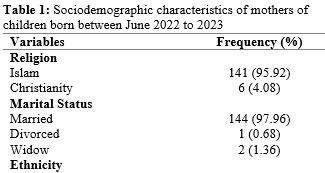Influence of Maternal Age and Birth Weight on Type 1 Diabetes Risk
Insights from a Retrospective Study
DOI:
https://doi.org/10.54117/ijph.v4i2.31Keywords:
Type 1 diabetes, Maternal age, Birth weight, Birth order, Retrospective Cohort, NigeriaAbstract
Background: Diabetes mellitus is a significant health concern, particularly in children, thus, maintaining normal glucose levels during pregnancy is crucial for the health of both mother and fetus. Understanding the factors that contribute to the risk of diabetes diagnosis is crucial for early intervention and prevention.
Objective: This study investigates the association between maternal factors, such as birth weight, birth order, maternal age, and the risk of type 1 diabetes in children in Bauchi State, Nigeria.
Methods: A cross-sectional retrospective cohort design was employed, using data from two major hospitals in Bauchi State. The study included 147 birth records from two major hospitals over one year (June 2022 to June 2023). Inclusion criteria encompassed gestational age less than 37 weeks and birth weights ranging between 1,500 and 4,499 grams. The exclusion criteria included instances of multiple pregnancies and major congenital anomalies. Data were analyzed using SPSS version 23, with linear regression to assess associations between maternal factors and childhood type 1 diabetes diagnosis.
Results: The regression analysis revealed that the model explained approximately 48.7% of the variance in diabetes diagnosis (R-square = 0.487). Maternal age (B = 0.012, p = 0.003) and child birth weight (B = 0.145, p < 0.001) were identified as significant positive factors, indicating that as maternal age and birth weight increase, the likelihood of diabetes diagnosis also increases. Conversely, paternal age showed a significant negative association (B = -0.021, p < 0.001). No significant associations were found between birth order and gender.
Conclusion: This study highlights the importance of maternal age and child birth weight as critical factors in predicting the risk of diabetes in children. The findings underscore the need for targeted interventions to mitigate these risk factors and improve maternal and child health outcomes in Bauchi State. Further research is warranted to explore the underlying mechanisms and develop comprehensive strategies for diabetes prevention in children.

Downloads
Published
How to Cite
Issue
Section
License
Copyright (c) 2024 Musab Usman Abba, Murtala Muhammad Jibril, Khadija Abdullahi Kobi, Abdulkadir Ishaq, Albashir Tahir, Muslim Muhammad Ahmad

This work is licensed under a Creative Commons Attribution 4.0 International License.
